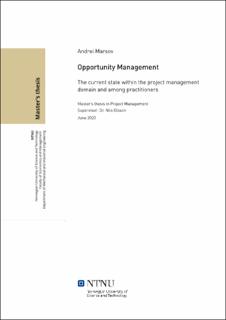| dc.description.abstract | Risk management is one of the major domains of project management. This process is essential for the successful project delivery and, therefore, widely applied among practitioners. The uncertainty management was introduced providing a possibility for the practitioners to have a broader view on the uncertain nature of the project internal conditions and its context by introducing positive risks, namely, opportunities, into the risk management process. It is believed that opportunity management shall be implemented within the scope of the uncertainty management process. However, as the practice shows, risk identification exercises make the involved individuals focus mainly on the threats’ identification and overlook opportunities.
Proactive opportunity management from the project manager’s perspective is characterized by managing operational and contextual positive risks over the entire project lifecycle. Thus, it is important to distinguish a formalized continuous approach to opportunity management from the stand-alone positive risk identification activities exercised in an ad hoc fashion because monitoring of discovered positive risks and seeking for opportunities on a regular basis throughout the entire project lifecycle prevents from losing a possibility to experience positive effects stemming from their exploitation, making suboptimal decisions and missing out favourable events which could be utilized by the project team to seize benefits.
The management of positive risks deserves serious attention from researchers and practitioners within the field of project management because identification of opportunities and their realisation have a potential to bring about positive effects facilitating the successful project delivery or bring the project back on track in case of cost overruns or delays. However, many researches highlight that there is a lack of studies devoted to opportunity management.
The purpose of this thesis was to define the current state of opportunity management within the project management domain and among practitioners.
The research method in this thesis was comprised of the visualization of the bibliometric networks covering the main research areas within the field of risk and uncertainty management, quantitative data acquisition, performed through a qualitative review of the publications retrieved from the academic databases, with regards to opportunity management-related papers within the project management domain, and systematic review of 46 case studies which describe the application of opportunity concepts and implementation of the opportunity management process on real-life projects.
The findings revealed that identification and exploitation of positive risks recently had not been paid enough attention to among the researchers despite the fact that examples from the real-life projects emphasize the importance of positive risk exploration by providing evidence of significant cost savings, reduced project duration and additional benefits to the project owner or the end-user which stemmed from the application of opportunity concepts.
Even though the majority of the opportunity concepts and positive risk identification methods is the same across the projects of different types and levels of complexity, the nature of their application differs. Restructuring projects usually contain a proactive opportunity hunting spirit in the core of the delivery model. The identification of positive risks on such projects is performed at the operational level since the project context is merged with the internal organizational conditions which represent a layer separating the operational project dimension from the environment external to the organization.
The utilization of the majority of opportunity-related concepts in product development is performed proactively in both project dimensions and eventually results in value creation for the project owner and the end-user after the product release or even during the development stage representing a first-order positive effect. The application of opportunity concepts or positive risk identification methods in product development is not only aimed at cost savings but also value-driven.
On the contrary, positive risk identification activities on construction projects are aimed at saving costs and time. The complexity necessitates the implementation of various positive risk-seeking activities which are performed in both project dimensions. Usually, exploitation and identification of positive risks are proactive at the front-end of the project and performed in a reactive fashion during construction.
The finding is this research provide an opportunity of knowledge transfer between the projects differentiated by application. Since the application of an established continuous opportunity management process was observed only among the practitioners in the construction industry, some features of the said process can be applied on other types of projects.
This research was constrained by some limitations including the comprehensiveness of the representation of critical qualitative information and data about the project objectives, goals, actual costs and duration, and quantitative evaluations of effects stemmed from the positive risks exploitation and return on investment from the application of opportunity concepts. The said constraints provide an opportunity for future research within the domain of positive risk management. Capturing the transformation of the project owner’s opportunity register and the distribution of positive risks between the contracting parties throughout the entire project lifecycle on construction projects implemented under different types of a contract through action research would supplement the decision-making process in the selection of the contracting strategy for the project owner. | |
